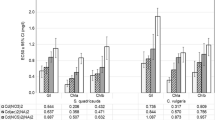Abstract
Effects of cadmium cations in free (Cd2+) and chelated with EDTA (Cd2+-EDTA) forms were studied on growth, endocytosis, and activity of glutathione S-transferase (GT) in the free-living infusoriaTetrahymena pyriformis. It is shown that the cytotoxicity of Cd2+ in the free form at a concentration of 10 μM is much higher than of the Cd2+-EDTA complex at the equimolar concentration. Even at a low concentration (2 μM), Cd2+ produces an inhibition of the growth rate and endocytosis in theT. pyriformis culture, while the Cd2+-EDTA complex suppresses these functions insignificantly. Cd2+ in the free form at concentrations of 10 and 100 μM reduced activity of glutathione S-transferase by 39 and 61%. The chelated Cd2+-EDTA complex at these concentrations inhibited the GT activity by 5 and 55%, respectively.
Similar content being viewed by others
References
Nilsson, J.K., Tetrahymena in Cytotoxicology with Special Reference to Effects of Heavy Metals and Selected Drugs,Eur. J. Protistol., 1989, vol. 25, pp. 2–25.
Carter, J.W. and Cameron, I.L., Toxicity Bioassay of Heavy Metals in Water UsingTetrahymena pyriformis, Water Res., 1973, vol. 7, pp. 951–961.
Hutner, S.H. and Marcus, S.L., Protozoological Approaches to the Cellular Basis of Mammalian Stress Repair,Int. Rev. Cytol., 1987, vol. 100, pp. 371–425.
Rana, S.V.S., Species Differences in Glutathione-Dependent Enzymes in the Liver and their Implications for Cadmium Toxicity,Ichthyological Res., 1996, vol. 43, pp. 223–229.
Korotkov, S.M., Glasunov, V.V., Rozengart, E.V.,et al., Action of Organic Cadmium Complexes of Different Degree of Hydrophobicity on Rat Liver Mitochondria,Tsitologiya, 1996, vol. 38, pp. 1075–1083.
Dunlop, S. and Chapman, G., Detoxication of Zinc and Cadmium by Freshwater ProtozoanTetrahymena pyriformis. II. Growth Experiments and Ultrastructural Studies on Sequestration of Heavy Metals,Environ. Res., 1981, vol. 24, pp. 264–274.
Houba, C., Kemacle, J., and De Parmetier, F., Influence of Cadmium onTetrahymena pyriformis in Axenic Culture,Eur. J. Appl. Microbiol. Biotechnol., 1981, vol. 11, pp. 179–182.
Jacobson, K.B. and Turner, J.E., The Interaction of Cadmium and Certain Other Metal Ions with Proteins and Nucleic Acids,Toxicology, 1980, vol. 16, pp. 1–37.
Pyne, C.K., The Effects of Cadmium on the Growth Pattern and Ultrastructure of the CiliateTetrahymena pyriformis, and Antagonistic Effect of Calcium,Biol. Cell, 1983, vol. 48, pp. 121–132.
Vasconcelos, S.D.M.T., Azenha, M.A.O., and Cabrai, J.P.S., Comparison of Availability of Copper (II) Complexes with Organic Ligands to Bacterial Cell and to Chitin,Microbiology, 1997, vol. 16, pp. 2029–2039.
Habig, W.H., Pabst, M.I., and Jacoby, W.B., Glutathione S-Transferases: the First Enzymatic Step in Mercapturic Acid Formation,J. Biol. Chem., 1974, vol. 249, pp. 7130–7139.
Lowry, O.N., Rosebrought, N.J., Farr, A.L., and Randall, R.J., Protein Measurement with the Folin Phenol Reagent,J. Biol. Chem., 1951, vol. 193, pp. 265–275.
Piccini, E., Irato, P., and Guidolin, L., Cadmium Thionein inTetrahymena thermophila andTetrahymena pyriformis, Eur. J. Protistol., 1990, vol. 26, pp. 176–181.
Cherian, M.G. and Nordberg, M., Cellular Adaptation in Metal Toxicology and Metallothionein,Toxicology, 1983, vol. 28, pp. 1–15.
Larsen, J. and Nilsson, J.P., Effects of Nickel on the Rates of Endocytosis, Mobility and Proliferation in Tetrahymena and Determination on the Cell Content of the Metal,Protoplasma, 1983, vol. 118, pp. 140–147.
Mannervik, B., Alin, P., Guthenberg, C.,et al., Identification of Three Classes of Cytosolic Glutathione Transferase Common to Several Mammalian Species: Correlation between Structural Data and Enzymatic Properties,Proc. Natl Acad. Sci. USA, 1985, vol. 85, pp. 7202–7206.
Dierickx, P.J.,In vitro Inhibition of the Soluble Glutathione S-Transferases from Rat Liver by Heavy Metals,Enzyme, 1982, vol. 27, pp. 25–32.
Clark, A.C. and Revie, W., The Comparative Enzymology of the Glutathione S-Transferases from Nonvertebrate Organisms,Comp. Biochem. Physiol. B, 1989, vol. 92, pp. 419–446.
Dierickx, P.J., Glutathione S-Transferase in Aquatic Macroinvertebrates and Its Interaction with Different Organic Micropollutants,Sci. Total Environment, 1984, vol. 40, pp. 93–108.
Author information
Authors and Affiliations
Rights and permissions
About this article
Cite this article
Shemarova, I.V., Maizel’, E.B. & Khovanskikh, A.E. Comparative study of effects of cadmium cations in free and chelated forms on activity of glutathione S-transferase, growth, and endocytosis in culture of the infusoriumTetrahymena pyriformis . J Evol Biochem Phys 36, 111–117 (2000). https://doi.org/10.1007/BF02754322
Received:
Issue Date:
DOI: https://doi.org/10.1007/BF02754322




